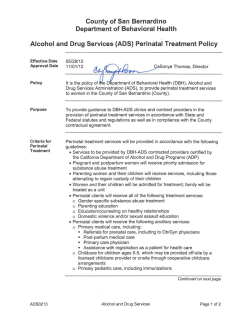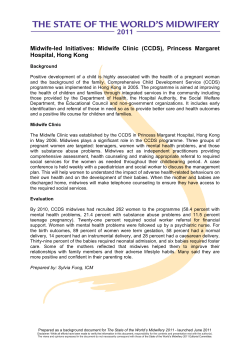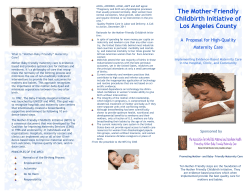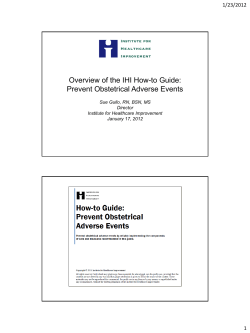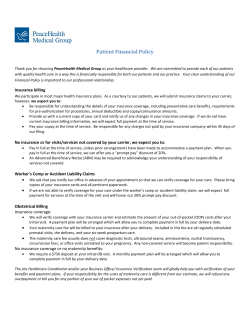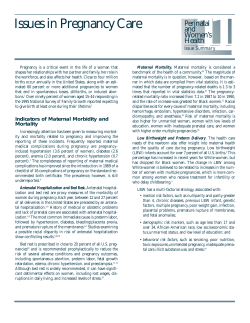
Six Success Stories in Making Pregnancy Safer
Six Success Stories in Making Pregnancy Safer Contents Foreword..................................................................................................................................................... 3 Introduction................................................................................................................................................ 5 The family in focus: Effective Perinatal Care........................................................................................ Convinced by sound evidence: evidence-based medicine............................................................. Audits without fear: Beyond the Numbers...................................................................................... 8 11 14 Self-examination on the ward: assessment of the quality of care............................................... 17 The best care in the right place: regionalization of care............................................................... 20 Addressing the system: strategic approach for making pregnancy safer.................................... 23 Foreword Childbirth is mostly a positive experience but, in many parts of the world, mothers and babies still die unnecessarily as a result of preventable factors. Lack of access to services contributes to these deaths, as does the lack of providers’ capacity to identify and manage complications and provide the right support to women and their newborn babies. Broader determinants – such as education, income, poverty and gender inequalities – also influence the outcome of childbirth. Although maternal mortality is decreasing in the WHO European Region, significant inequities in access to quality care still exist between and within countries. For the last decade, the WHO Regional Office for Europe has supported countries in using an evidence-based approach through its Making Pregnancy Safer programme. Member States and partners recognize this programme as a powerful forerunner in setting models of intervention and supporting the implementation of best practices in maternal and neonatal health. This work also contributes to the global efforts to reach the Millennium Development Goals (MDGs); MDGs 4 and 5 address the health of mothers and children. Member States value the health of mothers and their children as a fundamental asset to society and a pillar of health systems’ performance. The experience gained over the years shows which interventions work, and provides several examples of their successful implementation in countries. The following stories show how Making Pregnancy Safer is an effective champion in public health issues, working with partners to achieve continuous improvement in maternal and neonatal health through effective policy dialogue and cooperative action. Nevertheless, everyone should remember that achievements take time and that we have every reason to continue the work beyond the MDG targets. Complications of pregnancy and childbirth still rank among the causes of death and disability in young women and babies – deaths that in many cases can be prevented. Societies are obliged to make use of available evidence-based approaches to prevent these avoidable deaths, but need to do more. The WHO Regional Office for Europe will continue to coordinate and carry out actions with partners to ensure the attainment of the highest possible level of health for mothers and babies. Zsuzsanna Jakab WHO Regional Director for Europe 4 Introduction This brochure documents some of the success stories from the work of the WHO Regional Office for Europe – through its Making Pregnancy Safer programme (MPS) – in the European Region in the past 10 years. MPS is active in the countries with the greatest needs: the newly independent states and the Balkan countries. The ultimate goal of its work is to help improve the health of and care for mothers and babies. Building on existing programmes and the characteristics of the Region, MPS designed a framework and steps for implementation, including a set of complementary tools specifically adapted for these countries. Moreover, it has created a roster of international and local experts. Partner agencies such as the United States Agency for International Development (USAID), the United Nations Children’s Fund (UNICEF), the United Nations Population Fund (UNFPA) and others play an indispensable role in disseminating MPS methodologies and materials throughout the Region. First, MPS designed a training package, Effective Perinatal Care, to stop unnecessary and harmful practices and initiate a number of low-cost, family-centred practices supported by evidence. Unlike earlier training courses, this one teaches doctors, midwives and nurses together instead of separately, and combines theoretical training with clinical practice. In addition, it emphasizes the role of the midwife, often an underpaid and underestimated professional. The next step was the introduction of evidence-based medicine, a new concept for some health professionals. The programme conducts a course training professionals to find the best available scientific evidence for any intervention, to learn how to develop clinical guidelines and to harmonize their working practices with them. In some countries, fear of punishment from health authorities has crippled accurate reporting and real case reviews in the maternity wards, and thereby hindered necessary improvements. WHO developed a methodology called Beyond the Numbers to identify the reasons behind maternal deaths and serious complications. When the other components were implemented, MPS started supporting the use of confidential, professional enquiries, without blame or punishment, ensuring that needed changes in care provision and organization can be made. With the assessment of the quality of hospital care for mothers and newborn babies, WHO offers maternity hospitals the chance to make a comprehensive check of their services and identify key areas needing improvement. This tool lists essential medicines and equipment, measures staff 5 routines with international standards, includes service users’ views and makes recommendations for the hospital team and the health system. Regionalization of perinatal care is an approach intended to rationalize existing health care services to ensure that each mother and baby is cared for in an appropriate facility, with clear criteria for where different risk categories should give birth and indicators for monitoring results. Using a bottom-up approach, MPS involves key professionals in redesigning the organization of perinatal care. The European strategic approach for making pregnancy safer provides countries with guidance on developing or updating policies for health system reform. The related tool for assessing the performance of the health system guides health staff, administrators and politicians to evaluate the health care complex and find ways to amend the shortcomings encountered. Over the years, experience has shown that the right combination of these tools and activities benefits the health of mothers and babies. These stories attempt to present an authentic picture of MPS work, and it is hoped that you will enjoy reading them. Alberta Bacci, MPS coordinator (centre), with a local team at the Fergana maternity hospital, Uzbekistan –––––––––––––––––––––––––––––––––––––––––––––––––––––––––––––––––––––––––––––––– For more information on the Regional Office’s work for maternal and newborn health, see its web site (http://www.euro.who.int/en/what-we-do/health-topics/Life-stages/maternal-and-newborn-health). 6 7 The family in focus: Effective Perinatal Care The core activity of Making Pregnancy Safer illustrates the saying that unity breeds strength. Collectively training midwives, nurses and doctors in improving care for mothers and babies is the essence of effective perinatal care. In a corner of a room, a midwife is cutting a piece of light, flowery material to make new curtains, while a young neonatologist painstakingly draws a large, red apple on one of the walls. Flowerpots are produced from no one knows where, and placed by the side of a bed, while a group of eager nurses covers chairs and tables with cheerfully printed textiles. The scene is a delivery room in a small maternity hospital in the town of Kurgan-Tyube, Tajikistan. Originally the room contained nothing more than a bed and a washbasin, but now it is undergoing a substantial change. Local midwives, nurses, neonatologists and obstetricians/gynaecologists are redecorating it with all the ingenuity they can muster and whatever materials they can find. Their efforts are part of a two-week training package called Effective Perinatal Care (EPC), designed by the WHO Regional Office for Europe to introduce more open and family-centred care, where rigidity and hierarchy were previously the norm. “What we teach is basically that all care should be family-centred and evidence-based,” explains one of the course trainers, obstetrician/gynaecologist Gelmius Siupsinskas. Moreover, the course encourages the participants to question their own routines, and sometimes discard practices that they have previously considered appropriate. “We also stress that the role of midwives should be upgraded, and that only essential, low-cost interventions should be made. We ask the group to critically examine every drug prescribed and examination carried out on a patient,” says Siupsinskas. After one week of theoretical tuition, members of the group are now about to begin practising their newfound skills at the city’s maternity hospital. Once the delivery room is rendered more welcoming, they are ready to take on their first delivery. After a while, a young woman turns up with her husband. When asked, he agrees to stay and support his wife during the delivery. For most Tajik men this would be unthinkable, but Izatullo, 25, is quick to adopt the idea. 8 Evidence-based and family centred care is the basis of Gelmius Siupsinskas’ work in EPC “My wife and I have decided to support each other in difficult situations, so it really feels quite natural for me, even if I wasn’t expecting to be asked,” he says. Izatullo turns out to be the perfect support, patiently holding, stroking, supporting and encouraging his wife Zulligja during her ordeal. After four hours their efforts are crowned with the birth of a healthy son, whose name will be Shodmehr, the couple announces. “I really liked the way the nurses and doctors treated me and the little one,” says Zulligja afterwards, as she rests in the two-bed room she shares with another mother, with their newborn infants tucked up in high iron cots beside them. “I felt I was in charge the whole time, and allowed to choose the position that was most comfortable for me.” At the course’s closing event, the participants dress up for the occasion, the women in long, brightly patterned dresses, the men in suits. Participants and trainers gather in the lecture room with invited guests of honour, including representatives from the Ministry of Health of Tajikistan and the WHO Country Office in Dushanbe. The guests include three of the mothers who have given birth during the week. The group members reflect on their experiences during the two weeks. Eight healthy babies have been born, three delivery rooms redecorated and many new practices learnt. Midwife Djamilya Sultanova sums up her impressions: “This is a much more rewarding and interesting way of working. I didn’t even notice how the time was passing during the deliveries.” 9 10 Convinced by sound evidence: evidence-based medicine Evidence-based medicine (EBM) has almost changed the life of Stelian Hodorogea, at least in the workplace. He trains midwives and doctors across eastern Europe in the concept. Among the family photos and yellow adhesive notes on to the wall above his desk at the Municipal Perinatal Centre of Chisinau, capital of the Republic of Moldova, hangs a quotation in bold print: “Patient satisfaction is one of the main indicators of health care quality”. To Hodorogea, the practice of asking the patient’s opinion and involving her in decision-making is one of many benefits of EBM. “It’s doubtless the best way to obtain satisfied patients and avoid complaints,” he says. “It is a method that was never practiced in this country earlier, and one which many of my colleagues still find difficult to embrace.” Besides working as an obstetrician/gynaecologist at the Perinatal Centre of Chisinau and an Assistant Professor at the Medical University in the capital, Hodorogea trains medical professionals in maternity hospitals across eastern Europe in the concept of EBM. “My favourite definition of EBM is that it is the integration of the best available data with the clinical experience of the doctors and the preferences of the patients,” he says, adding that the word patient is not really appropriate for professionals working in obstetrics. “We ought to say ‘users’, since most of the women we work with are healthy.” The EBM concept emerged in the 1990s, referring to a clinical strategy stating that every measure taken in medical care should be based on the best available scientific evidence. Accomplishing this involves a process of systematically searching for and evaluating contemporary research findings, and incorporating them into practice. This means that EBM requires new skills of medical professionals, including the ability to seek information efficiently and assess results. While the habit of practising medicine based on sound evidence is not new, recent decades’ information boom has given the strategy new and previously unimagined possibilities. Today, EBM is increasingly seen as a new benchmark in medicine, replacing the traditional medical paradigm based on authority. The content and reasoning of the concept form an integral part of all other tools and approaches developed by MPS at the WHO Regional Office for Europe. 11 Introducing EBM in the eastern countries in the WHO European Region is a reform critically needed to improve not only medical education and practice but also the quality of research and publications. Learning to accept the need to change the way one has always worked is a painful process, however. Stelian Hodorogea remembers his first encounter with the doctrine at a course he attended some 10 years ago: “I was shocked. The idea that we could critically question our own practices was entirely new to me. In the past, we were cut off from the rest of the world, without access to western research. It was startling to find out that so many of the medical practices used in other parts of the world were different to ours.” When MPS organized the first EBM training programme in the Republic of Moldova in 2003, Hodorogea’s new insights were confirmed. Since then he has spread the word in maternity hospitals across the region. Asked to give examples of changes brought about by the introduction of the concept in his country, he gives a long list: from practical alterations, such as introducing the presence of women’s partners at deliveries, to the implementation of more effective treatment for complicated conditions such as pre-eclampsia. “And most importantly: I’m no longer limited to consulting only my colleagues. I can observe practices used in other countries which have much better results than ours,” he says, and adds: “I would almost say that EBM has changed my life. At least professionally.” Stelian Hodorogea 12 13 Audits without fear: Beyond the Numbers From a rigid system in which audits were aimed at punishing culprits, the Beyond the Numbers tool has released a surge of intensified teamwork, improved the quality of care and increased professional pride at a maternity hospital in Tashkent, the capital of Uzbekistan. The topic is a serious one – the case of a patient who developed life-threatening complications but survived – but the atmosphere in the airy conference room is informal and friendly. The eight assembled nurses, midwives and doctors all join in the discussion with keen interest, and every now and then someone breaks their intentness with a joke. What is taking place at the Republican Perinatal Centre in Tashkent is a survey of severe morbidity, or a “near-miss” review, and a small revolution. “Before we implemented Beyond the Numbers, we were petrified of theses reviews,” recalls obstetrician/gynaecologist Shakhida Babajanova, who is one of the participants at the meeting and the hospital’s deputy director. We used to sit in stiff rows, while our superiors on the podium read out the list of mistakes that had been made on the ward, and called us up to testify one by one. One or two colleagues would be proclaimed guilty and punished, but the recommendations that came out of the audits were mostly inapplicable, and often the same mistakes were made again and again.” The contrast between what she describes and the present session is palpable. Here, the aim is to analyse what has happened, not to apportion blame. No names are mentioned, since the enquiry is confidential, and the hospital’s management is not present at the meetings. Each of the colleagues calmly describes his or her contribution to the events, and makes an effort to avoid both accusations and excuses. “In the past, everyone would try to suppress the details of what had occurred to avoid punishment, and it was absolutely out of the question to ask for the woman’s version of the case,” says Babajanova. The MPS programme developed Beyond the Numbers (BTN) to go beyond mere statistics on 14 Relaxed atmosphere as Shakhida Babadjanova (second left), Nargiza Akhmedjanova (second right) and colleagues discuss a near-miss case maternal deaths and disabilities, to investigate the real reasons why pregnancies and childbirths sometimes go wrong and thus enable the necessary actions to take to improve the quality of care. Interviewing the women who survive to tell their stories is part of the approach. A further important feature is the order of topics followed in the review. After the presentation of the case at hand, the first topic for discussion is an evaluation of what was done well, so as to avoid focusing only on the negative elements. Having done this, the team examines why things took the particular course that they did, and what could be improved on the ward. BTN has been implemented in several of the countries where MPS is active. The Republican Perinatal Centre in Tashkent is one of the facilities where it has had the most striking effect. Midwife Nargiza Akhmedjanova describes how the sessions have changed her professional role and self-esteem: “When there was a case with complications in the past, I used to just bring the woman to the emergency department and let a doctor take over. Now I feel confident enough to follow our guidelines and provide the necessary first-aid interventions myself.” To round off the session, the team agrees on a set of realistic recommendations that can be carried out with existing resources in the facility, and appoints a person to be responsible for their implementation. At the next session, in about a month’s time, they will check whether the recommendations have been carried out. “BTN has improved our relationships on the ward. Nowadays I recognize that I’m a member of the team, and as responsible as anyone else for providing care,” says Nargiza Akhmedjanova. 15 16 Self-examination on the ward: assessment of the quality of care A new WHO tool for assessing the quality of perinatal hospital care is being put to use in Kazakhstan. Employing the tool requires both professional skill and passion “Do you know how to treat breast soreness? How often do you think you ought to breastfeed?” In a crowded room on the postnatal ward at the Oblast Perinatal Centre in Chimkent, neonatologist Inna Glazebnya is interviewing a group of new mothers. “I breastfeed every half-hour,” ventures a young mother in a brightly coloured bathrobe. “No, no, that is far too often!” the other mothers protest. Inna Glazebnya listens attentively and writes down their responses on her notepad. She is not the only outsider going around asking questions in this particular hospital today. Glazebnya, a Kazakh neonatologist, belongs to an assessment team travelling round the country to evaluate the quality of care offered to mothers and newborn babies in a handful of hospitals. Their mission forms part of a two-year project to support maternal and child health in Kazakhstan, which is funded by the European Commission and supported technically by the WHO Regional Office for Europe. Inna Glazebnya asks new mothers about their breastfeeding habits In a morning meeting with managers and staff from the maternity and neonatology departments, the guests explain the purpose and scope of their visit. “Our mission is not to check on you, but to try to assess the status of your work, give you the possibility to improve your practices and bring them in line with international standards,” clarifies Lithuanian obstetrician/gynaecologist Gelmius Siupsinskas. He heads the team, with two other international experts. 17 “We want to collect as much information as we can. We would like to observe your work, take a look at your equipment and medications, see documentation from present and former users. And of course talk, both to you and to the women who give birth here.” The visitors explain the twofold purpose of the exercise. Besides providing the hospital with a picture of its strengths and weaknesses, the assessment will give the Kazakh Ministry of Health an indication of the needs and problems of perinatal hospital care in the country. Anonymous feedback from all four hospitals will be sent to the Ministry, to provide a solid basis for future action. After the meeting, the assessment team splits up into smaller groups and spreads out across the various departments. Following a detailed manual and working in pairs, members collect material on everything that influences the quality of care at the hospital. The team is made up of midwives, obstetricians/gynaecologists and neonatologists from all over the country. Everyone assesses a particular area in line with his or her field of work. In the afternoon, the assessment team meets again with the hospital management and staff, to give preliminary feedback on its findings. Later on, it will provide a full report, identifying weaknesses and focal points for improvement, but now the response is oral. The assessors note that a number of WHO recommendations have already been implemented. Midwives are confident in their work, but overloaded, since there are far too many deliveries taking place at the hospital, medicines are overused on the wards, and few medical records are kept in a way that meets international criteria. Further, there is a lack of teamwork among the staff. “I found it very useful to have people from the outside point out things we don’t notice ourselves in our everyday work” obstetrician/gynaecologist Dzhamilya Boribayeva comments after the meeting. Team leader Gelmius Siupsinskas is pleased with the day’s work, and ascribes much of the success to the abilities of the assessment team: “You need both personal and communicative skills to do the job well, and be driven by conviction, perhaps even passion. When we select people for the team we don’t look for lecturers, but for believers. You have to be passionate if you want to convince other people to opt for change.” 18 19 The best care in the right place: regionalization of care Her broad, open face is tired but contented, as she sits on the hospital bed beside her neatly swaddled newborn. There were some complications this time, so she was referred here, to a tertiary-level maternity hospital. In a meeting room in another part of the hospital, a lively discussion is taking place, very much to do with her situation. Arguments fly across the room as a group of health professionals, hospital managers and representatives of the regional government discuss the new referral system in their province. Beneath the apparent discord, however, consensus is growing among the workshop participants that regionalization is the way to reduce maternal and infant mortality in Kazakhstan. The term “perinatal regionalization” refers to a method that rationalizes existing health care services to ensure that each pregnant woman and newborn infant is cared for in an appropriate facility. Maternity facilities are divided into three levels of care: the primary provides for normal pregnancies and healthy babies, the secondary is for pregnancies at moderate risk and the tertiary is a regional referral centre with a neonatal intensive care unit. Bringing all the high-risk infants together at the third level enables the necessary expertise to develop, to give each baby the best chance of survival. A referral system is created, with clear criteria indicating where women of different risk categories should give birth, and directions for transport from one level to another. Regionalization was officially implemented in the South Kazakhstan region in October 2009. The WHO Regional Office for Europe’s MPS programme has organized a series of three workshops in the region. Since regionalization has begun producing better organization and improved health outcomes for babies and mothers, the Ministry of Health has decided to extend the process to several other provinces by 2011. On the maternity ward, there are clear signs that the process has been initiated, but there is still some way to go before it functions as intended. Several of the postpartum wards are overcrowded to a degree that suggests that far too many women are being admitted without a sound medical reason. 20 Meruert Ziyabekova, happy to have been referred to a tertiary-level hospital for the birth of her fourth child Meruert Ziyabekova has just given birth to a little boy, who is now sleeping beside her in one of the cramped postpartum wards. She is a farmer’s wife and no more than 25 years old, but already a mother of four. Her first three children were delivered in the local maternity hospital back home, but this time there were some complications, so she was referred to the regional centre. She is happy about this opportunity: “Even though it is a bit crowded, they take good care of you here, and if a problem arises they know how to deal with it.” Around the workshop table, the debate continues. Madina Kokenova, head of a secondary maternity hospital in Chimkent, feels the project has been too hurried, but that the bottom-up approach is valuable: “Everything is not in place yet, and it’s important that the authorities listen to the needs of us workers, who face reality every day.” Leila Ukibayeva, chief obstetrician/gynaecologist of the South Kazakhstan Regional Health Department, is enthusiastic: “This is a revolutionary process, and in the beginning many old professionals were sceptical, but now no one is openly against it any longer.” One of the workshop facilitators, neonatologist Audrius Maciulevicius, notes that things have really begun to move in the region: “There is a noticeable change already, and we can expect more dramatically improving figures of maternal and infant mortality in one or two years.” 21 22 Addressing the system: strategic approach for making pregnancy safer “You can’t transform medical practices in a country only by changing them hospital by hospital; you need to address the health system itself,” says paediatrician and WHO expert Giorgio Tamburlini. A two-day workshop in Astana puts his words to the test. As the activity draws to a close, one of the participants, district paediatrician Polina Slugina, reflects over the impact of the two days: “The workshop was important since it gave me a chance to get my message across to the central level. Anyone … will know that, until a law is passed at top level, nothing will change in this country.” In the beginning, the Regional Office MPS programme focused on training health professionals and changing practices and clinical guidelines; these produced visible results that created confidence in the health authorities. Then came the time to address a broader issue, by bringing all the earlier components together and devoting attention to the entire health care system. The first step along this road was taken in Catania, Italy in 2008, where a WHO meeting of leading experts created the European strategic approach for making pregnancy safer. It defines a number of principles and key issues, and serves as a guide for countries in developing or revising their national policies to improve maternal and infant health as part of health-system reform. The next step towards a more system-oriented approach was to develop a tool to make the new strategy operational: the tool to assess the performance of the health system. It helps stakeholders and partners to identify weak areas and priority actions in their health care system, and to plan, set a time frame and identify the responsible agents for the completion of these actions. “The tool helps motivate all involved levels – from midwives and doctors to managers and politicians – to go beyond merely thinking about their individual workplaces, to begin evaluating strengths and weaknesses of the entire system,” says Giorgio Tamburlini, one of its main architects. A pilot version was tried out in Albania in 2008, and a year later Kazakhstan put a revised edition to the test. During a two-day workshop in Astana in August 2009, around 40 participants, from medical 23 professionals to managers and politicians, worked first on a revision of Kazakhstan’s national strategy and then with the assessment tool. The workshop formed part of the EU project to support maternal and child health in Kazakhstan, funded by the European Commission and with technical support from the WHO Regional Office for Europe. Working in groups and using the MPS strategic approach, the participants identified gaps and obstacles to improvement, and finished the first day by selecting their main priorities for action. On the second day, they used the assessment tool to take the analysis a step further. Selecting three or four priority issues, they discussed which actions needed to be taken, and who should be responsible for them. Finally, the participants specified a realistic time frame for taking the action. “The whole idea behind this method is that the participants understand all the steps that need to be taken for a change to take place,” says Giorgio Tamburlini, summarizing the process. “They were all burning issues, but we discussed them in a constructive way,” commented senior expert Magripa Yembergenova from the Kazakh Ministry of Health at the end of the workshop. “This kind of exercise helps people engage in developing a common understanding.” Polina Slugina and Giorgio Tamburlini during the Astana workshop 24 25 Address requests about publications of the WHO Regional Office for Europe to: Publications WHO Regional Office for Europe Scherfigsvej 8 DK-2100 Copenhagen Ø, Denmark Alternatively, complete an online request form for documentation, health information, or for permission to quote or translate, on the Regional Office web site (http://www.euro.who.int/pubrequest). © World Health Organization 2010 All rights reserved. The Regional Office for Europe of the World Health Organization welcomes requests for permission to reproduce or translate its publications, in part or in full. The designations employed and the presentation of the material in this publication do not imply the expression of any opinion whatsoever on the part of the World Health Organization concerning the legal status of any country, territory, city or area or of its authorities, or concerning the delimitation of its frontiers or boundaries. Dotted lines on maps represent approximate border lines for which there may not yet be full agreement. The mention of specific companies or of certain manufacturers’ products does not imply that they are endorsed or recommended by the World Health Organization in preference to others of a similar nature that are not mentioned. Errors and omissions excepted, the names of proprietary products are distinguished by initial capital letters. All reasonable precautions have been taken by the World Health Organization to verify the information contained in this publication. However, the published material is being distributed without warranty of any kind, either express or implied. The responsibility for the interpretation and use of the material lies with the reader. In no event shall the World Health Organization be liable for damages arising from its use. The views expressed by authors, editors, or expert groups do not necessarily represent the decisions or the stated policy of the World Health Organization. 26 Credits Text: Malin Bring Photographs: Malin Bring except page 6: Marianna B. Tamburlini page 15: Alberta Bacci Printed in Sweden by Davidsons Tryckeri AB,Växjö Making Pregnancy Safer Programme Population’s Health and Lifecycles World Health Organization – Regional Office for Europe Scherfigsvej 8 – 2100 Copenhagen, Denmark Tel. +45 39 17 17 17 – Fax +45 39 17 18 18 Website: http://www.euro.who.int/pregnancy
© Copyright 2025
